Building an app for Brick 1100
Note
It is recommended to read the Introduction first to understand the background of Brick 1100, how it works, and the related tools before continuing with this guide.
In this guide, let's build a simple Password Generator app and get it running on Brick 1100.
This Password Generator app will generate a random password based on the user's input for the length of the password (maximum 30 characters). Below is a preview of the final app:
1. Setup
1.1. Tool
- Install Visual Studio Code on your device.
- This is the recommended code editor for this guide.
- Install the Live Server extension in Visual Studio Code.
- This extension will help you to run your app locally and see the changes in real-time.
- After the above steps, you should see a
Go Livebutton at the bottom right corner of Visual Studio Code.
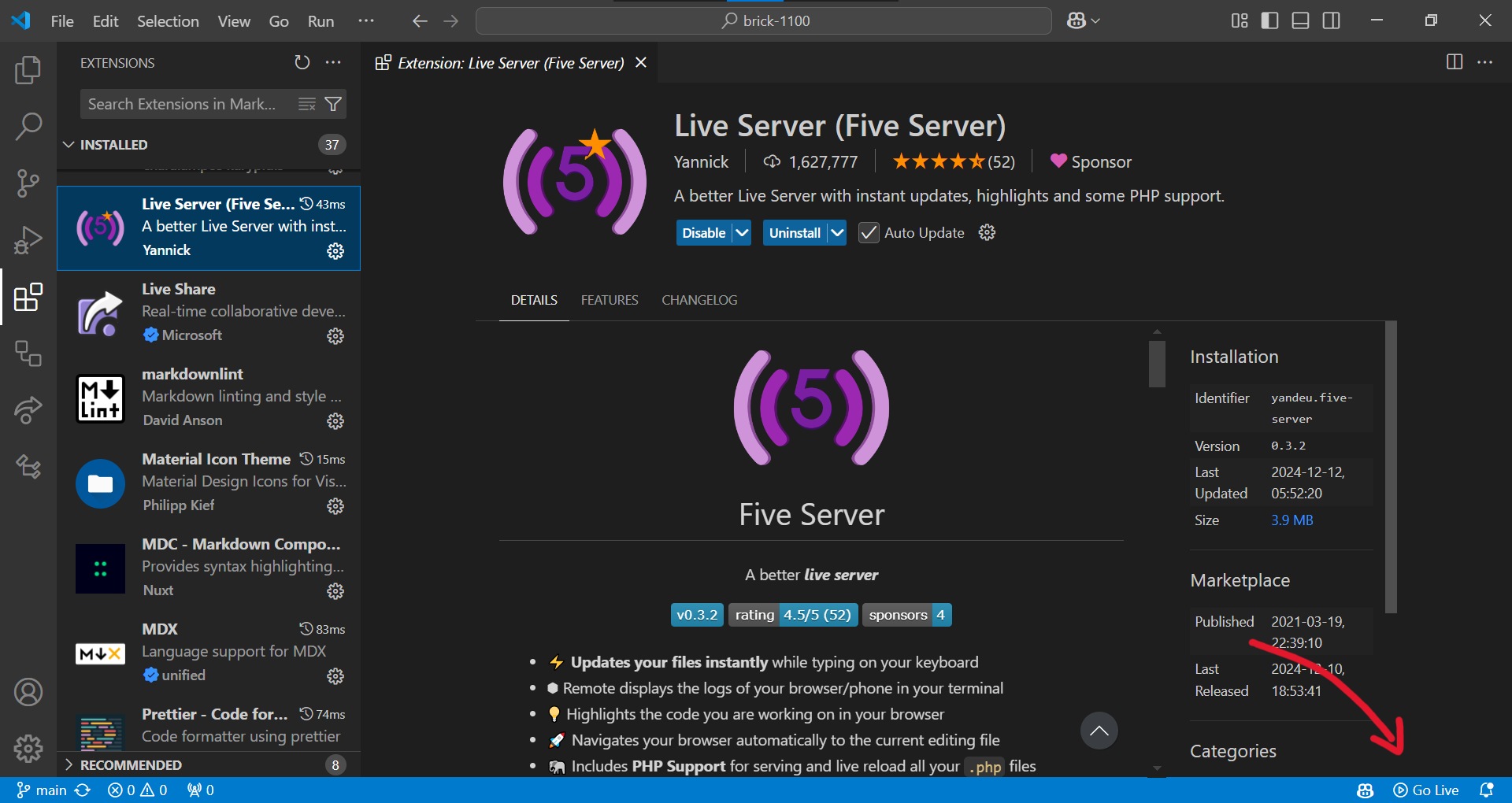
1.2. Codebase
- Create a GitHub account if you don't have one.
- Fork the Brick 1100 Apps directory repository to your account.
- This repository contains the source code of all apps built for Brick 1100. Your app will be added to this repository upon completion.
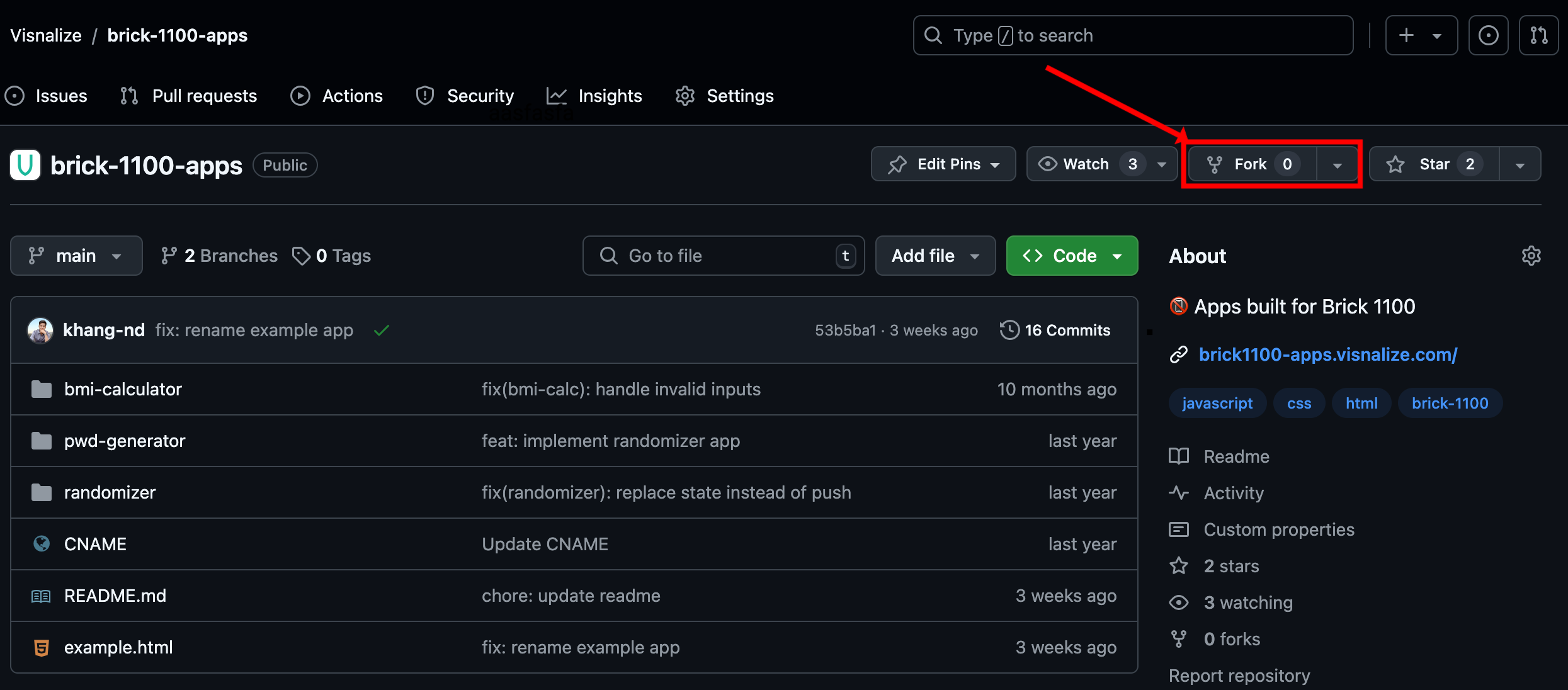
Clone the forked repository to your Visual Studio Code:
Copy the repository URL as shown in the below screenshot.
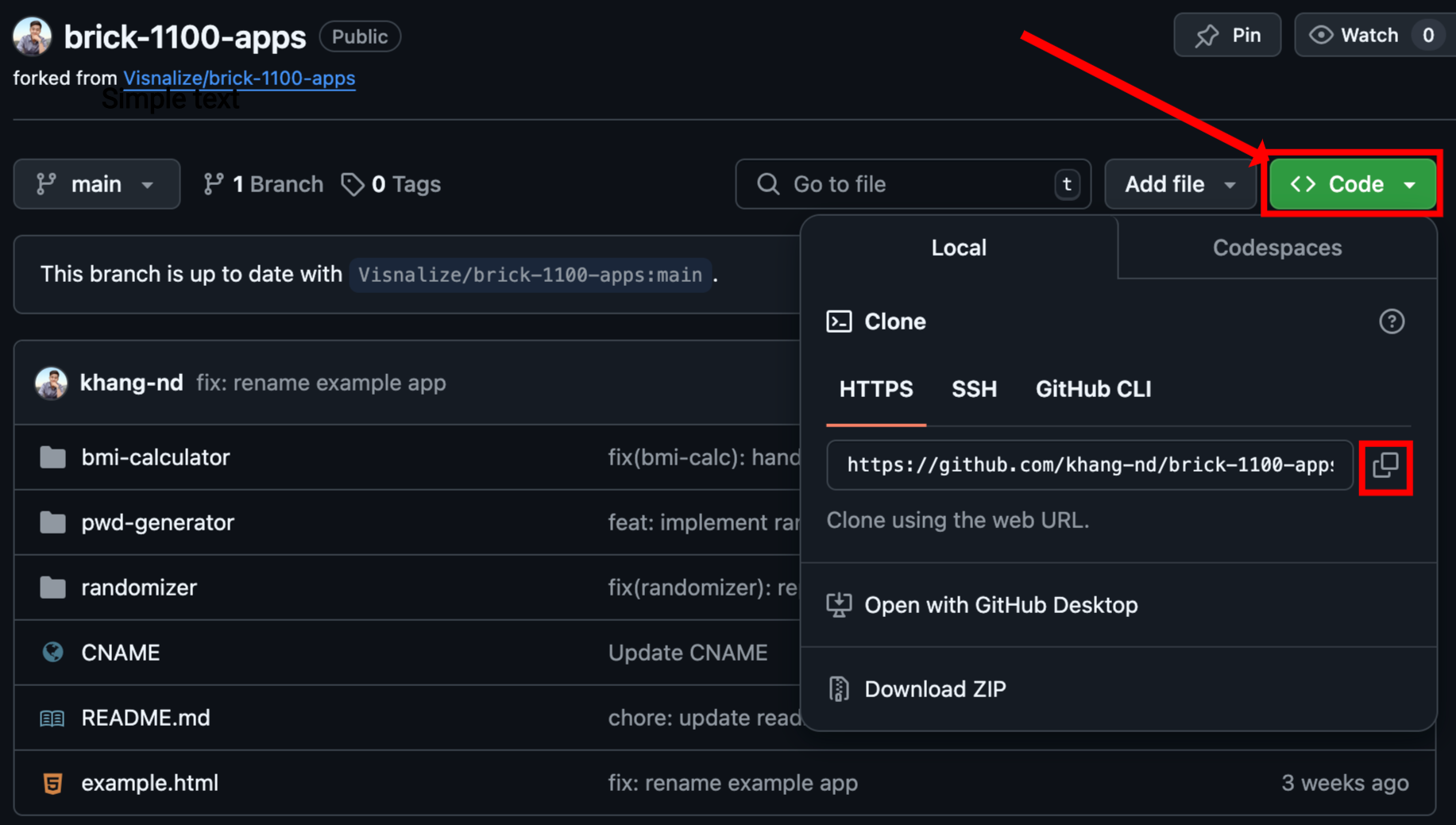
In Visual Studio Code, open the terminal (select
View > Terminalfrom the menu or pressCtrl + `) and run the following command:bashgit clone <repo_url>Replace
<repo_url>with the copied URL, e.g.https://github.com/<username>/brick-1100-apps.git.
Once the repository is cloned, you will see the source code in your Visual Studio Code.
2. Build
- In your Visual Studio Code, create a new folder named
pwd-generatorinside thebrick-1100-appsfolder. This folder will contain the source code of the Password Generator app. - Start the Live Server by selecting the
pwd-generatorfolder, right-clicking, and selectingOpen with Five Server (root).

- A new browser tab with the URL
http://127.0.0.1:5500will open, now every change you make to this folder will be reflected in real-time.
2.1. App structure (HTML file)
- Create an
index.htmlfile inside thepwd-generatorfolder with the below content:
<!DOCTYPE html>
<html>
<head>
<title>Password Generator</title>
<link rel="stylesheet" href="https://unpkg.com/bridge-1100/dist/index.css">
<link rel="stylesheet" href="https://unpkg.com/bridge-1100/dist/font.css">
<link rel="stylesheet" href="style.css">
</head>
<body>
<div class="screen">
<label>Password length</label>
<div id="input"></div>
<footer>Generate</footer>
</div>
<div class="screen" hidden>
<span>Your password:</span>
<div id="output"></div>
<footer>OK</footer>
</div>
<script src="https://unpkg.com/bridge-1100/dist/index.umd.js"></script>
<script src="script.js"></script>
</body>
</html>- The app consists of two screens:
- The first screen is for the user to input the length of the password.
- The second screen displays the generated password.
- Note the highlighted lines:
- Line 6 and 7: these are links to the Bridge 1100 CSS and fonts files, they help enforce your app's interface to fit seamlessly with Brick 1100's monochrome visual.
- Line 24: this is a link to the Bridge 1100 JavaScript file, it helps bridge the communication between your app and Brick 1100.
Bridge 1100 should be used in your app to maintain the visual consistency of your app with Brick 1100 and to ensure the app works correctly without having to invent the communication logic between your app and Brick 1100.
2.2. App logic (JS file)
- Create a
script.jsfile inside thepwd-generatorfolder. In this file, we will write the logic for the Password Generator app. - From the HTML structure above, we retrieve the input and output elements:
var input = document.getElementById("input");
var output = document.getElementById("output");- Then define the character set for the password generation and a variable for storing the generated password:
var charset = "abcdefghijklmnopqrstuvwxyzABCDEFGHIJKLMNOPQRSTUVWXYZ0123456789!@#$%^&*()-_=+";
var password = "";- Next, we will leverage Bridge 1100 to listen for
keypressandnumpressevents to handle the user's input:
window.bridge.on("keypress", handleKeypress);
window.bridge.on("numpress", handleKeypress);- We implement the
handleKeypresshandler function as below:
function handleKeypress(key) {
if (typeof key === "number" && input.textContent.length < 2) {
input.textContent += key;
}
if (key === "clear") {
if (input.textContent.length > 0) {
input.textContent = input.textContent.slice(0, -1);
} else {
stop();
}
}
if (key === "ok") {
if (input.textContent.length > 0 && !password) {
generatePassword();
} else {
stop();
}
}
}Let's break down the above implementation:
- The
handleKeypressfunction accepts akeyargument, this is provided by Bridge 1100 when a key is pressed on Brick 1100. For more information, refer to Bridge 1100 documentation. - When the user presses a number key, the password length is updated in the input field. The input length is limited to 2 characters.
- When the user presses the Clear key, the password length input is reduced by 1 character. If the input is empty, the app calls the
stopfunction. - When the user presses the OK key, if the password length input is available and the password is not yet generated, the app calls the
generatePasswordfunction, otherwise, thestopfunction is called.
- The
The
generatePasswordfunction generates a random password based on the user's input for the length of the password. If the password length exceeds 30 characters, the app calls thestopfunction. We implement it as below:
function generatePassword() {
var length = parseInt(input.textContent);
for (var i = 0; i < length; i++) {
var randomIndex = Math.floor(Math.random() * charset.length);
password += charset.charAt(randomIndex);
}
if (password.length > 30) {
return stop({ error: "Out of range" });
}
input.parentElement.hidden = true;
output.parentElement.hidden = false;
output.textContent = password;
}- The
stopfunction resets the password and sends a message to Brick 1100 to close the app. We implement it as below:
function stop(data) {
password = "";
window.bridge.send(window.parent, { event: "stop", data: data });
}- Putting it all together, the
script.jsfile should look like this:
Click to open
var input = document.getElementById("input");
var output = document.getElementById("output");
var charset = "abcdefghijklmnopqrstuvwxyzABCDEFGHIJKLMNOPQRSTUVWXYZ0123456789!@#$%^&*()-_=+";
var password = "";
window.bridge.on("keypress", handleKeypress);
window.bridge.on("numpress", handleKeypress);
function handleKeypress(key) {
if (typeof key === "number" && input.textContent.length < 2) {
input.textContent += key;
}
if (key === "clear") {
if (input.textContent.length > 0) {
input.textContent = input.textContent.slice(0, -1);
} else {
stop();
}
}
if (key === "ok") {
if (input.textContent.length > 0 && !password) {
generatePassword();
} else {
stop();
}
}
}
function generatePassword() {
var length = parseInt(input.textContent);
for (var i = 0; i < length; i++) {
var randomIndex = Math.floor(Math.random() * charset.length);
password += charset.charAt(randomIndex);
}
if (password.length > 30) {
return stop({ error: "Out of range" });
}
input.parentElement.hidden = true;
output.parentElement.hidden = false;
output.textContent = password;
}
function stop(data) {
password = "";
window.bridge.send(window.parent, { event: "stop", data: data });
}When writing app logic with JS, it is recommended to use the ES5 syntax to ensure your app works on a wider range of devices, especially older devices that may not have the latest JavaScript features.
2.3. App styling (CSS file)
- Create a
style.cssfile inside thepwd-generatorfolder with the below content:
.screen:not([hidden]) {
display: flex;
flex-direction: column;
height: 100%;
}
#input {
border: 2vh solid #000;
display: flex;
align-items: flex-end;
justify-content: flex-end;
font-size: 20vh;
height: 100%;
}
#output {
display: flex;
align-items: center;
justify-content: center;
height: 100%;
word-break: break-all;
}
footer {
font-size: 12vh;
}Ensure your app's styling is consistent with Brick 1100's visual as much as possible. This decides whether your app will be accepted or rejected during the review process.
2.4. Preview your app optional
See main guide: Using Brick 1100 Previewer
3. Publish
3.1. Commit and push
- In your Visual Studio Code, switch to the Source Control view on the left sidebar.
- Stage all changes by clicking the
+button next to the files. - Write a concise commit message in the text box and click the
Commitbutton.
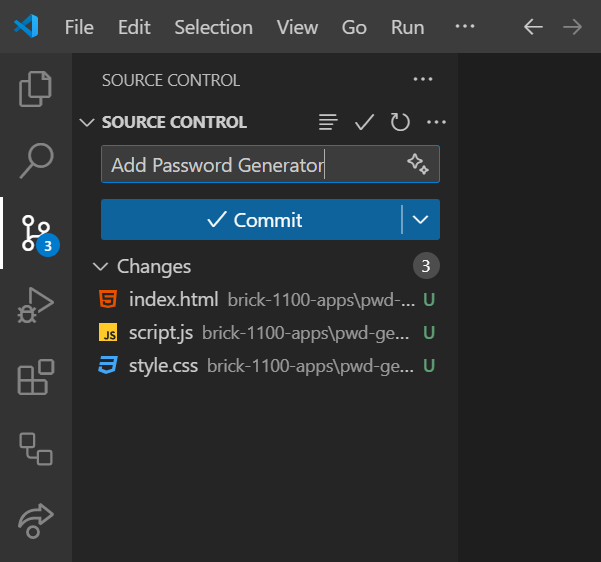
3.2. Open a pull request
- Open your forked repository on GitHub from step 1.2.
- Click
Contribute > Open pull request. This will create a pull request to merge your changes into the directory repository.
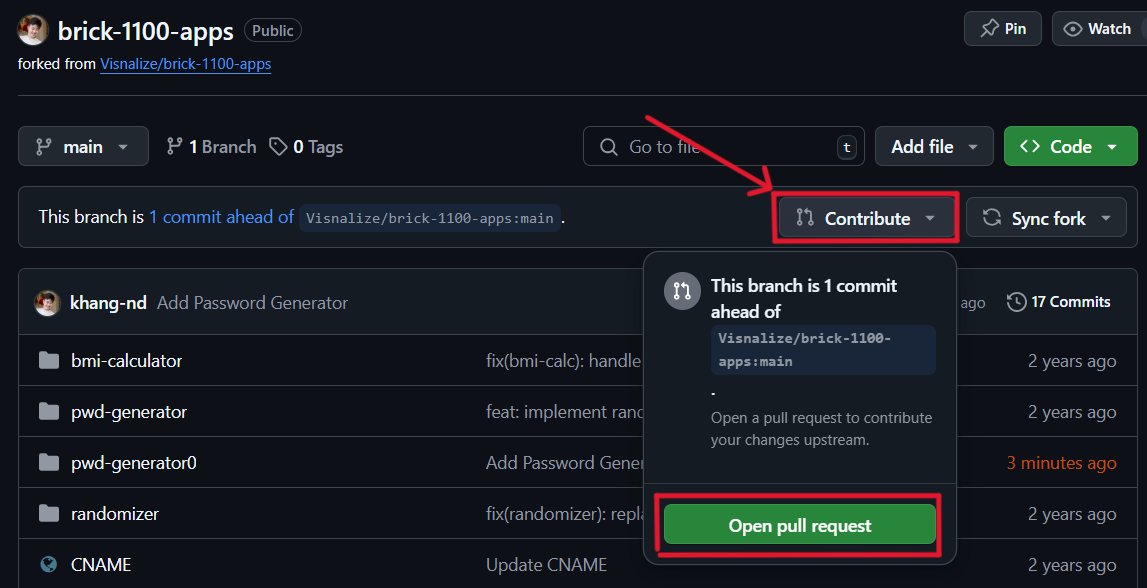
- On the pull request page, you can also preview your app again with the Netlify preview deployment link provided.
- Note: append your app's folder path in the preview URL to access it, e.g.
https://deploy-preview-2--brick1100-apps.netlify.app/pwd-generator/.
- Note: append your app's folder path in the preview URL to access it, e.g.
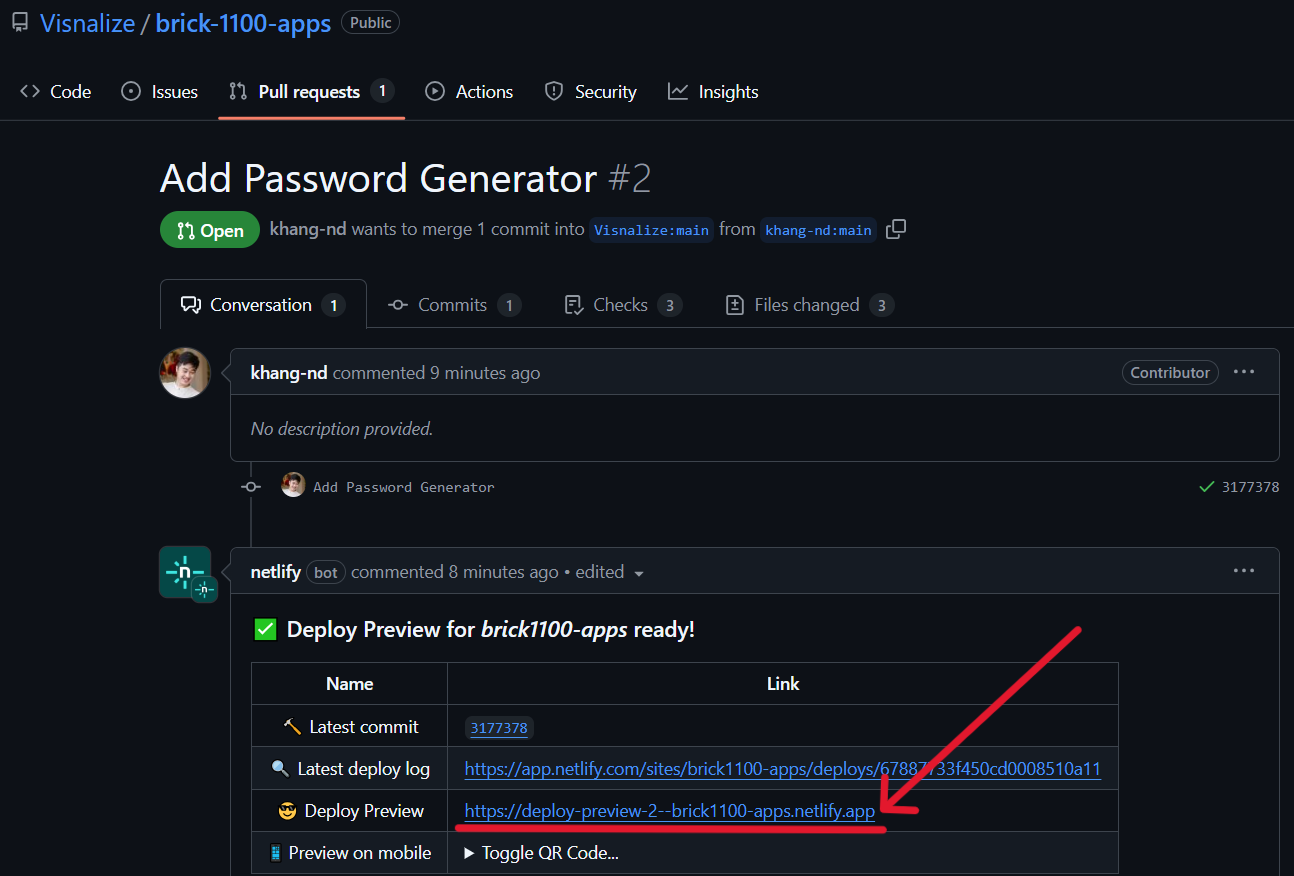
- 🎉 And that's it! Your app is now ready for review and will be available on Brick 1100 immediately once approved.